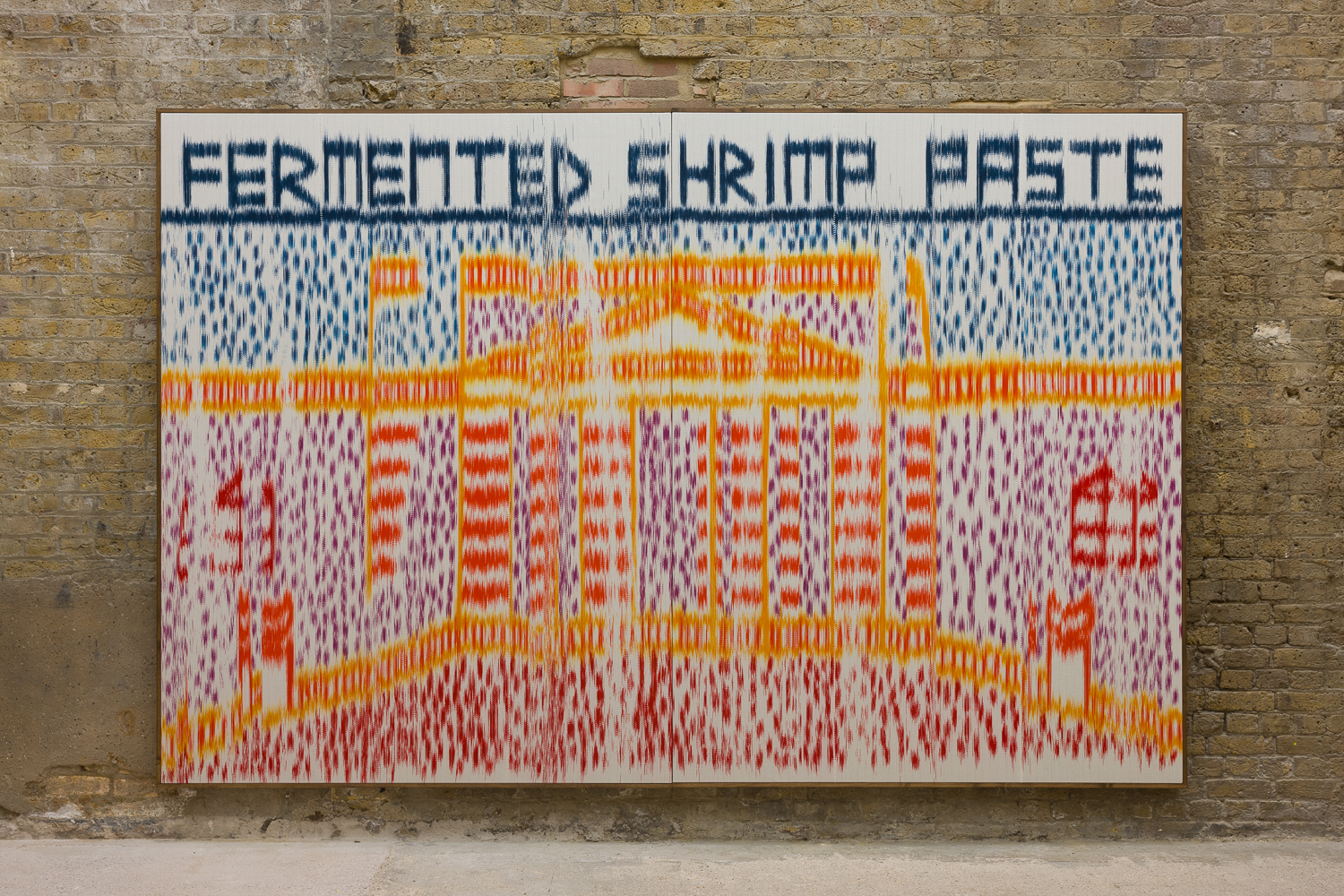TEXT – KHAIRANI BAROKKA ON MARK CORFIELD-MOORE
Click here for pdf version.
Mark Corfield-Moore: Menu
By Khairani Barokka
Presented to you are homes in meals.
‘Mum’s Jungle Curry’, ‘Family Picnic at Stourhead’, ‘Jelly, Your Favourite’.
These paintings by Mark Corfield-Moore are lineage in motion, heritage in the weaving of things. It is a practice that takes us to Mark’s grandmother in a village in Northern Thailand. Within his fingers are her fingers.
Mark perceives weaving as an art of transience, of time travel. Weaving is also a recreation of life, a presentation of memory refracted through thread, a memorialising in solid form, what he calls ‘digestion and understanding’.
In Indonesian, my language, ‘ikat’ refers to the textile technique shared with Thailand, to its creations, but it also means ‘to tie’. Language ties children to parents, and when Mark was small, he started to learn English, the language of his father, which would supersede Thai, his mother’s tongue. This meal of textiles is proof that linguistic memory is kept in the body.
Corfield-Moore’s shared language with his mother is food, recipes conceived in Southeast Asia and brought to the UK, a digestion, an understanding. Migration back and forth destabilises what we know, reconfigures our plates. As how ‘A Clean Slate’, ‘Dorset Garden’, and ‘Sleeping on the Floor’, for instance, contain fragmentations of image, glitch-like between vertical threads. The meals are transplanted and change in the process, and yet remain a form of heritage and interpretation.
The titles in text juxtaposed with the images, and the juxtaposition of both with the actual titles of these paintings (which are not the same as the text displayed) play with perceptions of Thailand and the UK from an outsider’s view. A bricolage of sense perception and the naming of snapshots, a recalling of how memory was seasoned, preserved. Reminiscent of how performance artists Arahmaiani and Cok Sawitri humorously tangle with and deconstruct how Southeast Asian cultures are ‘meant’ to be consumed for the West, simultaneously claiming them and keeping them.
These meals before you are tongue-in-cheek, but do not confuse them for surface rearranging of perceptions, an offering of Fermented Shrimp Paste because it was seen once. These are in fact deeply personal artifacts of strongly held memories of family and return, cooked up not for our consumption as non-Thai gallery-goers and image-lookers primarily. They serve a deeper purpose, as per the Indonesian meaning of ‘ikat’.
It is no wonder, then, that the arrangement of the pieces in the space is meant to convey a settlement, a visual poem, a village of gestation and conversation. The colours chosen are a rainbow array of sensorial impressions, to be consumed readily, belying the complexity of what is being portrayed, life history, and how these refracted memories have been cooked up.
However, perhaps we as beholders will attach our own meanings to how and why a piece with the words ‘New Conservatory’ might be called ‘A Clean Slate’, how ‘Bangkok Rush Hour’ is tied (diikat) to ‘Surprise! Surgery!’, what an ‘Angry Air Hostess’ might have to do with ‘Sleeping on the Floor’, why a piece reading ‘Bitter Farewell’ is entitled ‘Jelly, Your Favourite’—and why this last piece is starkly different from the others in terms of being black on mustard, a monotone memory. As per Édouard Glissant’s evocation of opacity and the right to it, Corfield-Moore conveys only what he wishes, and his memories refract into ours.
This process of creation is in alignment with:
Eating with your hands and weaving with them.
tastebuds as archives
cooking as parenting
parenting as a precursor to loss
loss as a precursor to creation
drifting as precursor to returning
location as precursor to contemplation
subtle freneticism in fibre as precursor to what the eye perceives when stepping back
individual works remaining part of the whole
leaving a village to rebuilding one elsewhere
to bringing a village into a spoonful
to bringing a spoonful into paint
to the manual labour of creating as inseparable from what is contained in the palms of one’s hand
to weaving as cooking
as painting
as speaking
as remembering
In the process of creating these works, the cook, too, has changed, cells turning over, mitochondria choosing what to keep.
‘Mum’s Jungle Curry’ is the title of the painting on which the words ‘Common Tongue’ are displayed.
Glitching between past, present, and future, this is Corfield-Moore speaking in both Thai and English. He offers a healthy platter to all of us, representative of what he has learned over many years to taste and recreate.
Read more…BIOGRAPHY
Khairani Barokka is a writer, editor, translator and artist from Jakarta, whose work has been published and presented widely internationally, and centres disability justice as anticolonial praxis, and access as translation. In 2023, Okka was shortlisted for the Asian Women of Achievement Awards.
Read Less...

